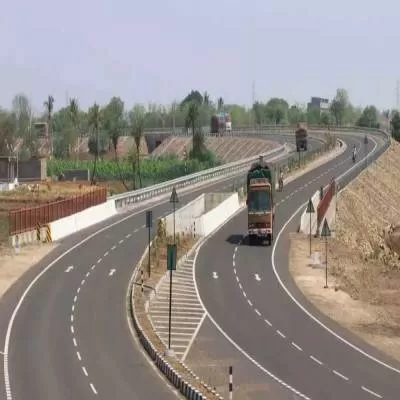- Home
- Infrastructure Transport
- ROADS & HIGHWAYS
- The silver lining
The silver lining
In the face of the stiff global economic meltdown witnessed 2012 onwards, India has felt the impact. Given that it had earlier opened up its economy to the world as part of its liberalisation policy meant that complete insulation from global events would never be possible. Though the impact is not as hard hitting as the world over, it has been felt during the current financial year. From an annual GDP growth rate of 9.3 per cent during 2010-11, it has dipped to 5 per cent during 2012-13, and recorded an even lower 4.4 per cent during the Q1 of 2013-14. The so called trilemma facing the Indian economy today is a triple whammy of soaring inflation, sluggish growth and a steep and alarming devaluation of the rupee. In addition, there has been the abysmally slow pace of implementation of obvious policy reforms by the government due to their own internal compulsions, which has further aggravated matters.
Infra impact: Economic growth and infrastructure development are complementary to each other one boosts the other and vice versa. One of the worst-hit sectors at the moment is infrastructure and this has manifested in poor demands, slack revenues, fading investments and resultant overall sluggish movement of projects across sectors. Balance sheets of infrastructure developers and contractors are stretched to the limit, their P&L sheets are in the red, and there is hardly any equity left with them to invest into projects or leverage for further debt. This is alarming in view of the fact that the Twelfth Five-Year Plan envisages about 40 per cent of the investment into infrastructure to come from the private sector. Banks and financial institutions are also badly hit with constantly increasing NPAs resulting in RBI tightening the regime of lending to the infrastructure sector further adding to the latter´s woes.
However, nothing is permanent and this too is bound to be a passing phase. Government of India has already acknowledged this challenge and has started implementing a number of much-awaited policy changes, especially in the highway sector, starting early 2013. Infrastructure companies including contractors, developers, operators, vendors, suppliers and consultants have devised improvised and innovative means to survive these hard times, till the growth path of the economy picks up again. Consultants hit: The overall slowdown in the ´supply´ of implementable infrastructure projects has had a direct impact on the consulting industry. Public sector projects have mostly become least cost bids in order to economise on costs, while PPP projects fare even worse since private sector clients are mostly cash-strapped; there have been many cases of private clients being unable to pay their consultants even for services satisfactorily rendered as per contract. In the wake of this, the consultants´ order books and turnover have been badly hit.
Staying afloat: Consultants are constantly improvising and coming up with innovative measures to stay afloat and tide over these hard times.
Roads and highways are amongst the worst hit sectors with a complete slowdown in the progress achieved in 2013-14 thus far, in both bidding and implementation of NHDP projects. In comparison, the rail sector, including metro rail, is less affected due to a relatively easy availability of multi-lateral funding, amongst other reasons. Accordingly, consulting firms are witnessing a shift in their sector focus companies with 40 per cent turnover coming from roads and highways and 20 per cent from rail are now seeing a reversal of this trend.
Human resource re-structuring consultancy is 90 per cent human resources and 10 per cent material resources; whereas in the contracting and construction industry, it is the other way around. Therefore, the one obvious measure is a comprehensive relook at human resources in a consultancy organisation, with a view to optimise and rationalise the same.
Consultancy firms are replacing high-cost senior experts with a larger number of low-cost juniors; they are rationalising the compensation package to increase performance-based variable pay and inter-alia reduce the fixed-pay component; there is a decline in technical training of staff and a very evident ban on recruitment despite attrition.
Indian firms are increasingly looking at overseas projects to bag the ´expatriate professional´ fee. Also, the ones here are consolidating their past ongoing projects which were languishing due to either lower priority rating or certain complexities. These projects are being addressed and completed during this lean phase.
Owing to their inherently different nature of business activity, developers and contractors have had to come up with their own measures to stay afloat. Some of it includes equity dilution or asset selling on operational projects; debt restructuring; refinancing and financial re-engineering of existing debts; manpower restructuring; retrenchment; and consolidation of ongoing projects and stop bidding for new projects altogether.
Hopes abundant: These tough times are bound to pass with time; however, it is also true that good times will not, and cannot just come steps and actions need to be taken to usher in a better economic regime. In all of this, a faint silver lining has already begun to emerge in terms of some recent developments. The Government of India has recently eased the norms for environmental clearance of infra projects, particularly for highway and power projects.
In order to revive languishing PPP projects, the government has initiated proactive and positive steps to consider issues of substitution of concessionaire, renegotiation of concessions, setting up mechanisms for dispute resolution and facilitate asset-selling in PPP infrastructure projects.Internal approval processes within the government for infrastructure projects have also been simplified and streamlined.RBI has issued a circular in March 2013 declaring that bank loans to the highway sector can now be considered as a secured loan and on the Indian economy front, though inflation stays high at 6 per cent, the rupee has regained 6 per cent of the ground which it lost since May this year. Further, the Sensex recently crossed 20,000, after a really long time. The Indian economy is in a state of ´repair´ right now, and is bound to bounce back once these repairs are done and over with. The infrastructure sectors will also begin to look up, but until then each infra stakeholder will have to continue to look for and take innovative steps in order to see themselves through these hard times.
About the author:
Avadesh Singh, Deputy CEO, Egis India Consulting Engineers, has over 28 years of experience in all aspects of infrastructure projects. An MTech Transportation Systems Engineering graduate from IIT- Mumbai, he has vast experience in project management using the latest software, contract management and construction management. Apart from engineering, his areas of specialisation are PPP financial advisory and PPP procurement.
In the midst of the current economic turmoil, AVADESH SINGH sees a glimmer of hope for the infrastructure sector. In the face of the stiff global economic meltdown witnessed 2012 onwards, India has felt the impact. Given that it had earlier opened up its economy to the world as part of its liberalisation policy meant that complete insulation from global events would never be possible. Though the impact is not as hard hitting as the world over, it has been felt during the current financial year. From an annual GDP growth rate of 9.3 per cent during 2010-11, it has dipped to 5 per cent during 2012-13, and recorded an even lower 4.4 per cent during the Q1 of 2013-14. The so called trilemma facing the Indian economy today is a triple whammy of soaring inflation, sluggish growth and a steep and alarming devaluation of the rupee. In addition, there has been the abysmally slow pace of implementation of obvious policy reforms by the government due to their own internal compulsions, which has further aggravated matters. Infra impact: Economic growth and infrastructure development are complementary to each other one boosts the other and vice versa. One of the worst-hit sectors at the moment is infrastructure and this has manifested in poor demands, slack revenues, fading investments and resultant overall sluggish movement of projects across sectors. Balance sheets of infrastructure developers and contractors are stretched to the limit, their P&L sheets are in the red, and there is hardly any equity left with them to invest into projects or leverage for further debt. This is alarming in view of the fact that the Twelfth Five-Year Plan envisages about 40 per cent of the investment into infrastructure to come from the private sector. Banks and financial institutions are also badly hit with constantly increasing NPAs resulting in RBI tightening the regime of lending to the infrastructure sector further adding to the latter´s woes. However, nothing is permanent and this too is bound to be a passing phase. Government of India has already acknowledged this challenge and has started implementing a number of much-awaited policy changes, especially in the highway sector, starting early 2013. Infrastructure companies including contractors, developers, operators, vendors, suppliers and consultants have devised improvised and innovative means to survive these hard times, till the growth path of the economy picks up again. Consultants hit: The overall slowdown in the ´supply´ of implementable infrastructure projects has had a direct impact on the consulting industry. Public sector projects have mostly become least cost bids in order to economise on costs, while PPP projects fare even worse since private sector clients are mostly cash-strapped; there have been many cases of private clients being unable to pay their consultants even for services satisfactorily rendered as per contract. In the wake of this, the consultants´ order books and turnover have been badly hit. Staying afloat: Consultants are constantly improvising and coming up with innovative measures to stay afloat and tide over these hard times. Roads and highways are amongst the worst hit sectors with a complete slowdown in the progress achieved in 2013-14 thus far, in both bidding and implementation of NHDP projects. In comparison, the rail sector, including metro rail, is less affected due to a relatively easy availability of multi-lateral funding, amongst other reasons. Accordingly, consulting firms are witnessing a shift in their sector focus companies with 40 per cent turnover coming from roads and highways and 20 per cent from rail are now seeing a reversal of this trend. Human resource re-structuring consultancy is 90 per cent human resources and 10 per cent material resources; whereas in the contracting and construction industry, it is the other way around. Therefore, the one obvious measure is a comprehensive relook at human resources in a consultancy organisation, with a view to optimise and rationalise the same. Consultancy firms are replacing high-cost senior experts with a larger number of low-cost juniors; they are rationalising the compensation package to increase performance-based variable pay and inter-alia reduce the fixed-pay component; there is a decline in technical training of staff and a very evident ban on recruitment despite attrition. Indian firms are increasingly looking at overseas projects to bag the ´expatriate professional´ fee. Also, the ones here are consolidating their past ongoing projects which were languishing due to either lower priority rating or certain complexities. These projects are being addressed and completed during this lean phase. Owing to their inherently different nature of business activity, developers and contractors have had to come up with their own measures to stay afloat. Some of it includes equity dilution or asset selling on operational projects; debt restructuring; refinancing and financial re-engineering of existing debts; manpower restructuring; retrenchment; and consolidation of ongoing projects and stop bidding for new projects altogether. Hopes abundant: These tough times are bound to pass with time; however, it is also true that good times will not, and cannot just come steps and actions need to be taken to usher in a better economic regime. In all of this, a faint silver lining has already begun to emerge in terms of some recent developments. The Government of India has recently eased the norms for environmental clearance of infra projects, particularly for highway and power projects. In order to revive languishing PPP projects, the government has initiated proactive and positive steps to consider issues of substitution of concessionaire, renegotiation of concessions, setting up mechanisms for dispute resolution and facilitate asset-selling in PPP infrastructure projects.Internal approval processes within the government for infrastructure projects have also been simplified and streamlined.RBI has issued a circular in March 2013 declaring that bank loans to the highway sector can now be considered as a secured loan and on the Indian economy front, though inflation stays high at 6 per cent, the rupee has regained 6 per cent of the ground which it lost since May this year. Further, the Sensex recently crossed 20,000, after a really long time. The Indian economy is in a state of ´repair´ right now, and is bound to bounce back once these repairs are done and over with. The infrastructure sectors will also begin to look up, but until then each infra stakeholder will have to continue to look for and take innovative steps in order to see themselves through these hard times. About the author: Avadesh Singh, Deputy CEO, Egis India Consulting Engineers, has over 28 years of experience in all aspects of infrastructure projects. An MTech Transportation Systems Engineering graduate from IIT- Mumbai, he has vast experience in project management using the latest software, contract management and construction management. Apart from engineering, his areas of specialisation are PPP financial advisory and PPP procurement.
























